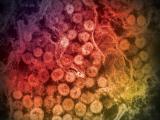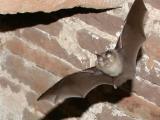Mar 14, 2013 (CIDRAP News) – Scientists reported yesterday that they have found the protein handle on human cell membranes that a recently identified coronavirus uses to latch onto the cells, a discovery that may open the way to drugs or vaccines to block the often-fatal infection and also may shed light on how the virus crosses species barriers.
Writing in Nature, a team of mostly Dutch scientists identified the receptor as dipeptidyl peptidase 4 (DPP4), a protein that has much the same amino acid sequence in several different species. That fits with findings reported last December that the virus can infect pigs, monkeys, and several kinds of bats, as well as humans.
The novel virus is known to be closely related to coronaviruses found in bats, but its animal or environmental source has not yet been found.
Fifteen cases of infection with the novel coronavirus (NCoV), with nine deaths, have been confirmed since the virus was identified last fall. They include 8 cases in Saudi Arabia, 2 in Jordan, 2 in Qataris who were treated in Europe, and 3 in the United Kingdom. All the cases had links to the Arabian Peninsula, and some of them came in family clusters.
The study was done by scientists from Erasmus Medical Center in Rotterdam, with collaborators from other centers in the Netherlands, Switzerland, and Saudi Arabia. The lead author is V. Stalin Raj of Erasmus. Among the authors is Ron Fouchier, PhD, of Erasmus, who was involved in identifying and characterizing the NCoV in 2012. The virus is also known as hCoV-EMC, for "human coronavirus–Erasmus Medical Center."
The team had previously determined that the receptor used by the novel virus is not ACE2 (angiotensin converting enzyme 2), the protein used by the SARS (severe acute respiratory syndrome) virus, which is also a coronavirus.
In studying the virus's spike protein, which enables it to enter cells, the scientists discovered that a part of the protein called S1 is what binds to human liver cells. They also found that S1 binds to one type of African green monkey kidney cell (Vero cells).
The next step was to analyze the bond between S1 and the human and Vero cells. Using mass spectrometry, the team learned that the protein that S1 was latching onto was DPP4.
Several additional steps strengthened the evidence that DPP4 was the receptor. For example, the researchers found that the abundance of DPP4 on the membranes of different cells types was consistent with the cells' susceptibility to the virus.
Further, they determined that antibodies to DPP4 protected human liver cells from infection with the virus. Also, cat, mouse, and dog cells that were not susceptible to the virus became susceptible after the team manipulated them to express DPP4.
The report says DPP4 "displays high amino acid sequence conservation across different species," including a species of bat (Pipistrellus pipistrellus) that is found in the Netherlands and harbors a coronavirus closely related to the novel virus.
The authors say it may be possible to combat NCoV infection by manipulating DPP4 levels or finding a way to prevent the virus from binding to it.
In an accompanying commentary, two scientists who weren't involved in the study write that the findings should help uncover how the novel virus and other coronaviruses jump species barriers, among other things. The piece is written by Tom Gallagher, PhD, of Loyola University Medical Center in Maywood, Ill., and Stanley Perlman, MD, PhD, of the University of Iowa in Iowa City.
A coronavirus that can infect cells from bats, pigs, monkeys, and humans "is highly unusual and, from an epidemiological perspective, seems alarming. The suggestion is that hCoV-EMC has acquired facile interspecies transmissibility by adapting to evolutionarily conserved host-cell components—including host-cell receptors," say Gallagher and Perlman.
They write that the new findings "validate this idea." Besides showing the consistency of DPP4 in different species, the study authors demonstrated that the bat version of DPP4 also functions as an hCoV-EMC receptor.
Gallagher and Perlman suggest one of the next steps is to scrutinize the "binding interface" between the receptor and the virus to find out if the latter connects exclusively to a piece of DPP4 that's the same in different species. Analyzing the bond between receptor and virus may also reveal possible ways to block the connection, they add.
The collective message from this study and previous research on the novel virus is that "there may be a plethora of sources for its intrusion into the human population," they write. But it remains to be seen if this is true or if there are some barriers to keep the virus from jumping species.
Other experts discuss this issue further in an accompanying Nature news story. The report says a key public health question is whether human cases of NCoV infection are "caused by occasional jumps from animal reservoirs, or whether the virus has adapted and is now a distinct human virus spreading between people."
Christian Drosten, MD, a virologist at the University of Bonn and a coauthor of the new study, said genetic data on human NCoV isolates should help answer the question, according to the story. He suggested that if genetic sequences from different human cases are much alike, it would suggest that the virus has adapted to humans. But if the sequences are more diverse, it might suggest that the virus is occasionally leaping from animals to humans.
Drosten also commented that the identification of DPP4 as the human receptor implies that the novel virus may resemble SARS in how it spreads, according to the story.
The SARS receptor is found mainly on cells deep in the lungs, which helps explain why the virus caused serious disease but did not spread very easily through coughing and sneezing, he said. He said the distribution of DPP4 in the lungs seems similar, which suggests the possibility of similar transmissibility.
Raj VS, Mou H, Smits SL, et al. Dipeptidyl peptidase 4 is a functional receptor for the emerging human coronavirus EMC. (Letter) Nature 2013 Mar 14;495:251 [Preview]
Gallagher T, Perlman S. Broad reception for coronavirus. (Commentary) Nature 2013 Mar 14;495:176 [Preview]
See also:
Mar 13 Nature news story "Receptor for new coronavirus found"
Dec 11, 2012, CIDRAP News story "New coronavirus can infect cells from multiple species"

















